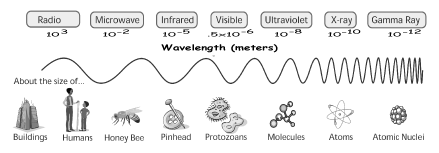The Anatomy of Black Holes - Page 9

|
All objects in our Universe emit, reflect, and absorb electromagnetic radiation in their own distinctive ways. The way an object does this provides it special characteristics which scientists can use to probe an object’s composition, temperature, density, age, motion, distance, and other chemical and physical quantities. While the night sky has always served as a source of wonder and mystery, it has only been in the past few decades that we have had the tools to look at the Universe over the entire electromagnetic (EM) spectrum and see it in all of its glory. Once we were able to use space-based instruments to examine infrared, ultraviolet, X-ray, and gamma-ray emissions, we found objects which were otherwise invisible to us (e.g., black holes and neutron stars). A "view from space" is critical since radiation in these ranges cannot penetrate the Earth's atmosphere. Many objects in the heavens "light up" with wavelengths too short or too long for the human eye to see, and most objects can only be fully understood by combining observations of behavior and appearance in different regions of the EM spectrum.
We can think of electromagnetic radiation in several different ways:
• From a physical science standpoint, all electromagnetic radiation can be thought of as originating from the motions of atomic particles. Gamma-rays occur when atomic nuclei are split or fused. X-rays occur when an electron orbiting close to an atomic nucleus is pushed outward with such force that it escapes the atom; ultraviolet, when an electron is jolted from a near to a far orbit; and visible and infrared, when electrons are jolted a few orbits out. Photons in these three energy ranges (X-ray, UV, and optical) are emitted as one of the outer shell electrons loses enough energy to fall down to the replace the electron missing from the inner shell. Radio waves are generated by any electron movement; even the stream of electrons (electric current) in a common household wire creates radio waves ...albeit with wavelengths of hundreds of kilometers and very weak in amplitude.
• Electromagnetic radiation can be described in terms of a stream of photons (massless packets of energy), each traveling in a wave-like pattern, moving at the speed of light. The only difference between radio waves, visible light, and gamma-rays is the amount of energy in the photons. Radio waves have photons with low energies, microwaves have a little more energy than radio waves, infrared has still more, then visible, ultraviolet, X-rays, and gamma-rays. By the equation E=hn, energy dictates a photon's frequency and, hence, wavelength.




